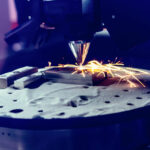While there are many different forms of metal 3D printing, more subtypes continue to crop up. They all serve various functions and there is no ‘one size fits all’ solution as of yet. Although, SLM printing is the closest contender for the title of most dominant form of metal printing. Taking up the challenge, researchers at Sheffield University seem to have set out to dethrone SLM’s coveted status.
Diode area melting (DAM) is a process that the UK-based researchers have pioneered. As the name suggests, this method utilizes diode lasers. DLs are electrically fed semiconductor lasers that can perform a range of functions. Their uses can range from data-recording/ reading CDs to surgical implementation. Typically, SLM uses single or multiple deflected fibre lasers, while DAM uses an array of diodes.
This array is confined in what researchers call a ‘DL bar’. This bar emits light over the printing materials and selectively melts regions into various shapes. During the process, the bar irradiates areas by switching the diodes on and off. Similar to SLA, researchers used a powder bed. However, DAM uses a vertical beam as opposed to a deflected laser.
Advantages of DAM
The paper goes into length about DAM’s advantages over SLM. SLM has, thus far, been one of the most common metal printing methods, though it still has its drawbacks. Firstly, DAM is far more energy efficient. Diode lasers can have a wall plug efficiency rate of 50-80%. This is why they are used in such a wide range of technologies.
Secondly, DAM allows for a smaller unit size and the ability to stack multiple laser bars. Along with the precise and quick surface heating, it gives it a better time efficiency as well. Additionally, it is also capable of larger scanning areas and bigger scales.
For those interested in further reading, the entire paper is available here.










